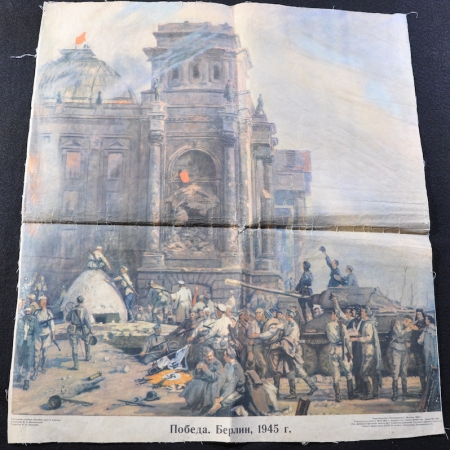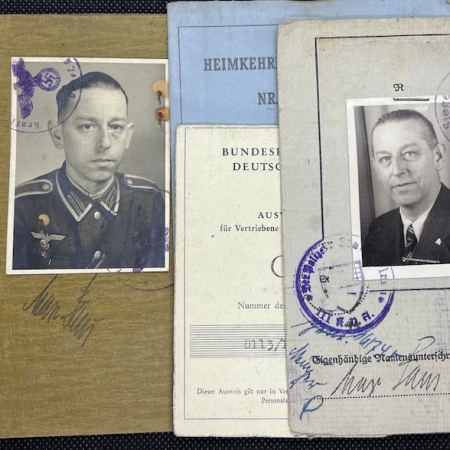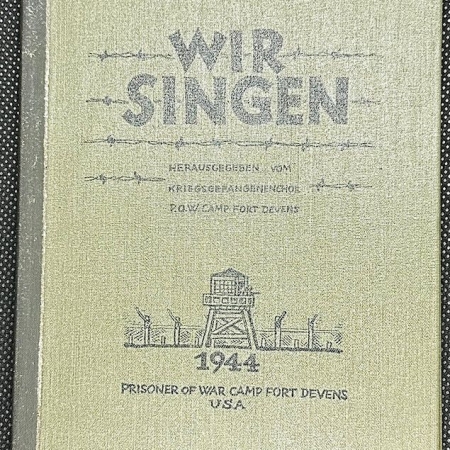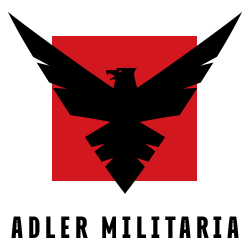Showing 109–117 of 1093 resultsSorted by latest
-

WWII Red Army Postcard – Sent from Berlin Cellar During Battle 1945 – Mentioned in a Book – Translated – Rare
A very interesting postcard, written in the basement of a Berlin House during the battle. This is featured in a book on the Battle of Berlin 1945, should be published this year. Translation Dear friend! I have received all your letters and am very glad and thank you many times, the only letters that I recieved, are yours. I congratulate you, and your relatives, with May 1st – day. I am writing this postcard sitting in a cellar in Berlin, so we have taken it, you may congratulate us. Besides, I was awarded the “Red Star Order”. Enough now, I’ll write more later.I embrace everybody and shake hands and wish you all the best with your exams. – Nikolay. (Sgt BESPALOV – 52330) * The Russians entered Berlin on April 22nd * The red stamp 27.4.45 is the date the unit “postal service” accepted the Postcard
-

WWII Red Army Soviet Postcard – Sent From Potsdam Berlin 1945 to Russia – Translated – Rare
(stamp) Field mail of the USSR 25.4.45 (stamp) Arkhangelsk Center USSR 554512 (stamp) VIEWED by Military censorship 19522 City of Arkhangelsk Petrogradskiy prospect house № 246 apartment № 3 Karpova Claudia Afanasievna Field mail 03757 Potsdam – 23rd Guards Rifle Division Hello from Berlin. Again there is no time (?) to write a letter, so (?) I am writing a postcard, otherwise you are probably worried. I live well and everything is great and already clav (?) in Berlin. But even in the very center I was not, you know, the city is very big. I don’t know about the center, but the suburbs are not very destroyed: yes, a large, culturally clean city. Although the weather is still cool again, all sorts of fruit trees are blooming. On this note I’m finishing, I will write in detail in the letter. Goodbye for now, my dear and beloved Claudia (?). Kiss, your Shura.
-

1946 KPD ID – Communist Party Germany – Original Post War ID – Rare
Here we have an original KPD ID for a German in Post War East Germany. I have not found another one of these dated 1946. Seems to be quite rare.
-

WWII Soviet Army at the Reichstag Berlin 1945 – Poster
Very nice Poster made in 1964 Moscow. Its about four times bigger than A4, printed on material. Depicting the Soviet Army at the Reichstag in Berlin 1945, nit seen another!
-

WWII German Wehrmacht / Waffen SS – M42 Helmet – Ex-Camo – Stahlhelm – Original
A nice Ex-Camo M42 with a 58 Liner inside. The decal was removed likely during the war as this is a bring back and was not offered for sale on the market before. It seems to be a toned Winter Camo under or a light Grey. Looks to be a late issue M42, with ersatz style leather on the chinstrap, and shell quality is not the best due to the production/war going on.
-

WWII German Army Soldbuch Grouping – Unteroffizier Max Faas – Wounded in the Battle of Berlin – Rathenow Spandau Line – General Holste – 1948 Ostzone KZ NKVD Special Camp – Escaped to West Berlin – Mentioned in Book – Rare Story
Soldbuch Issued in August 1939 with 3 Kompanie, Nachrichten Abteilung 3. Born in 1904 in Oberbayern Germany, he was in civilian life a technical salesman. Operated as a Radio Man, (Funker) with: Kraftfahr Ersatz Abteilung 23 in Sorau – Later moved to Rathenow (Berlin). Faas was married to Erika Faas they lived together with their two sons both children during the war in Frankfurt Oder. He had two awards during the war, a War Merit Cross with Swords and an October 1938 Medal. By January 1945, he was in the C Positions with Division Raegener on the Oder River. He even had leave granted for the later two weeks of January 1945, likely the last time he ever seen his family at their wartime home. Interestingly, he was sent home in 1943, due to the emergency with the harvests to help. Faas would only see real combat with General Holstes last attempt to relieve Berlin in the last days of the war, along with Steiner in the North and Wencks 12th Army south of them (See Below). Found fit for service at the Garde Füsilier Kaserne in Rathenow on the 3rd of April 1945. Faas was issued a full list of equipment, including iron rations in Rathenow on the 21st of April 1945. Armed with a FN Pistol (Personal Pistol). On the 26th of April 1945, Faas arrives at the Korps San Komp, Stab General Holste with a 31b – meaning grenade fragments from artillery, mortar or hand grenade. What we know about the movement of this ad hoc unit set up to try and break the ring around Berlin, which failed. “On 22 April 1945, Holste became part of a poorly conceived and incredibly desperate plan that Field Marshal Wilhelm Keitel and Colonel General Alfred Jodl proposed to Adolf Hitler. The plan envisaged for the few remaining German forces in central Germany to attack the Soviet forces encircling Berlin. The plan called for General Walther Wenck’s Twelfth Army on the Elbe and Mulde fronts to be turned around and to attack towards the east, then linking up just south of Berlin with General Theodor Busse’s Ninth Army. Then both armies would strike in a northeastern direction towards Potsdam and Berlin. Wenck’s objective would be the autobahn at Ferch, near Potsdam. Holste’s directive was to attack from the area northwest of Berlin with his XLI Panzer Corps across the Elbe between Spandau and Oranienburg. To give Holste as much punch as possible, Obergruppenführer Felix Steiner (who had been himself the subject of another desperate attempt by Hitler to save Berlin, a few days earlier) was to turn over to Holste his mechanized divisions (the 25th Panzer-Grenadiers and the 7th Panzer). Wenck’s army did make a turn around and attacked towards Berlin, but was soon halted outside of Potsdam by strong Soviet resistance. Neither Busse nor Holste made much progress towards Berlin. By the end of the day on 27 April, the Soviet forces encircling Berlin linked up and the forces inside Berlin were cut off. Late in the evening of 29 April, General Hans Krebs contacted Jodl by radio from Berlin and requested an immediate report on the whereabouts of Holste’s spearhead. On 30 April, Jodl replied that Holste’s Corps was on the defensive. Early on the morning of May 1, Holste is reported to have appeared at Twelfth Army HQ having abandoned his troops. A day later, on 2 May, the Battle for Berlin came to an end when General Helmuth Weidling unconditionally surrendered the city to the Soviets. Holste surrendered 8 May 1945. In 1947, he was released.” https://www.tracesofwar.com/persons/6868/Holste-Rudolf-Generalleutnant.htm Faas was moved to a different hospital, although he was captured by the Soviet Army. This is where it takes an unusual twist, according to his Heimkehrer Bescheinigung – A form of identification issued to people who have fled either from the Eastern Zone of Germany, or those suffering the aftermath including refugees of the war. This ID was issued in Berlin Marienfelde in 1954 – it clearly states he was a Prisoner of the Ostzone KZ – meaning German Eastern Zone Concentration camp – from 1948 till 1954. What his alleged crime was we will not be able to find out, maybe he tried to escape to go towards his family and was caught in December of 1948? The NKVD Speical Camps in Germany NKVD special camps (German: Speziallager) were NKVD-run late and post-World War II internment camps in the Soviet-occupied parts of Germany from May 1945 to January 6, 1950. They were set up by the Soviet Military Administration in Germany (SMAD) and run by the Soviet Ministry of Internal Affairs MVD. On 8 August 1948, the camps were made subordinate to the Gulag. Because the camp inmates were permitted no contact with the outside world, the special camps were also known as silence camps (German: Schweigelager). The Soviet occupation authorities did not admit to the existence of the camps until the Western press led the Soviet Union to respond with a moderate propaganda campaign of their own admitting and defending the camps’ existence.No inmates were released before 1948. On January 6, 1950, the camps were handed over to the East German government, who tried the remaining detainees. Officially, 157,837 people were detained, including 122,671 Germans and 35,166 citizens of other nations, at least 43,035 of whom did not survive. The actual number of German prisoners was about 30,000 higher. For more information: https://en.wikipedia.org/wiki/NKVD_special_camps_in_Germany_1945%E2%80%931950 Today the location Faas crossed into West Berlin is a museum, commemorating the long history of the building. (Erinnerungsstätte Notaufnahmelager Berlin Marienfelde) He was found not guilty of the alleged crimes and the German Government helped him and his two sons as refugees in their own country find a home again. Final Comments Max Faas passed away in the 1970s, a record exists in the German Archive along with his marriage certificate. His story is quite incredible, what he endured and of course what we will never know. But he was very…
-

WWII German Hitler Youth – BDM Membership Identification – Annalu Leopold – Bremen BDM – Original (Offer Accepted)
Annalu Leopold was born on the 19th of November 1924 in Bremeb, she entered the BDM on the 6th of July 1935. Original Membership ID issued in Berlin 7.3.1942 – Original Photo, quite hard to find these types of IDs.
-

WWII German POW Made Book – “Wir Singen/We Are Singing” Prisoner of War Camp Fort Devens USA – Rare German POW Made Book
Fort Devens also housed a prisoner of war camp for German and Italian prisoners from 1944 to 1946. In addition to training WWII combat Soldiers, Fort Devens was the home of the Chaplain School, the Cook and Baker School, and a Basic Training Center for Army nurses. Rare Book Pocket Size / Interior Loose
-

WWII German Army Wehrmacht Propaganda for GD Veterans 1944 – Panzer Grenadier Division Grossdeutschland – Baldur von Schirach – Rare (Offer Accepted)
Panzer Grenadier Division Grossdeutschland Late 1944 these both were made for veterans of the GD during the war. Quite rare and are around A4 size, slightly split/folded.




